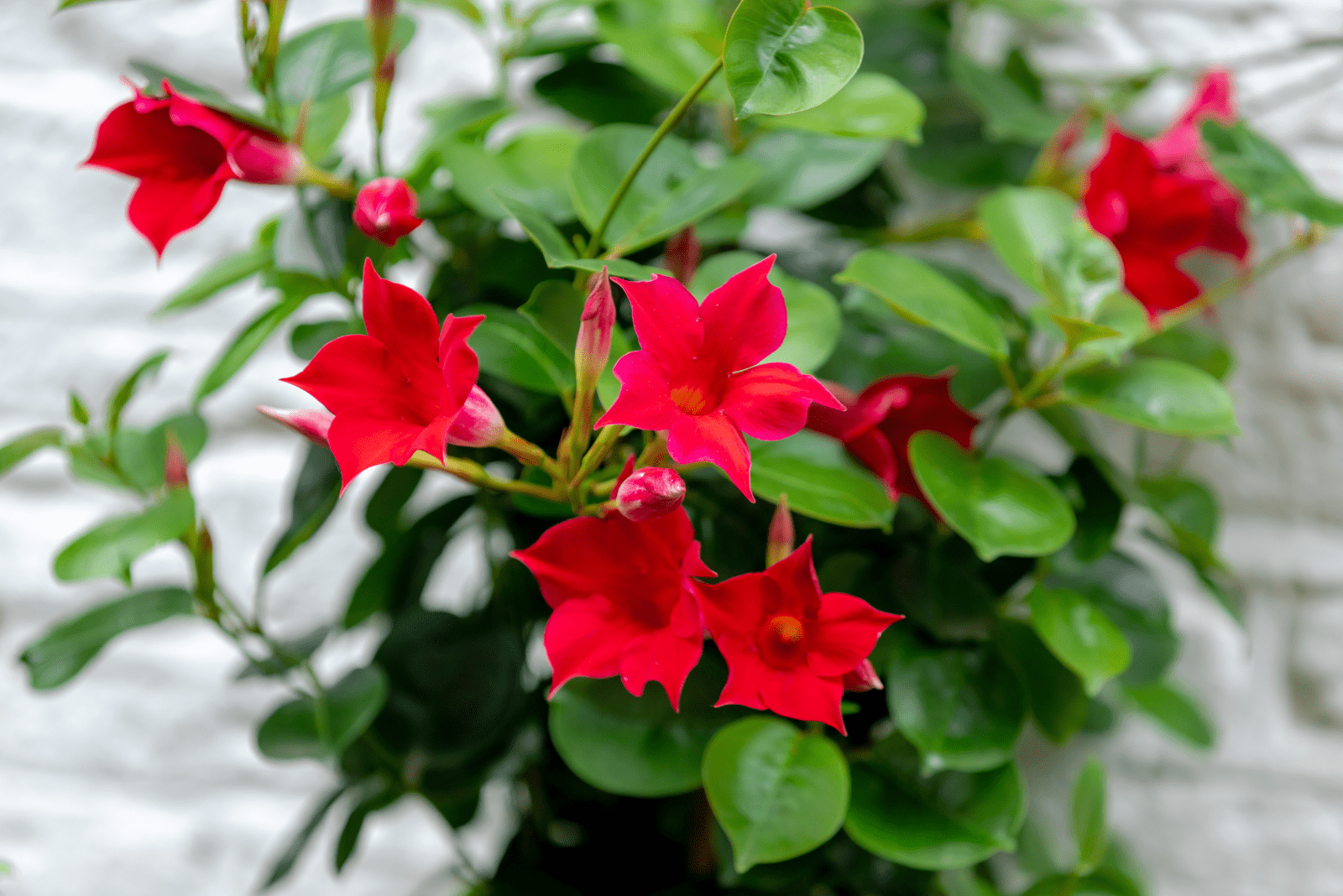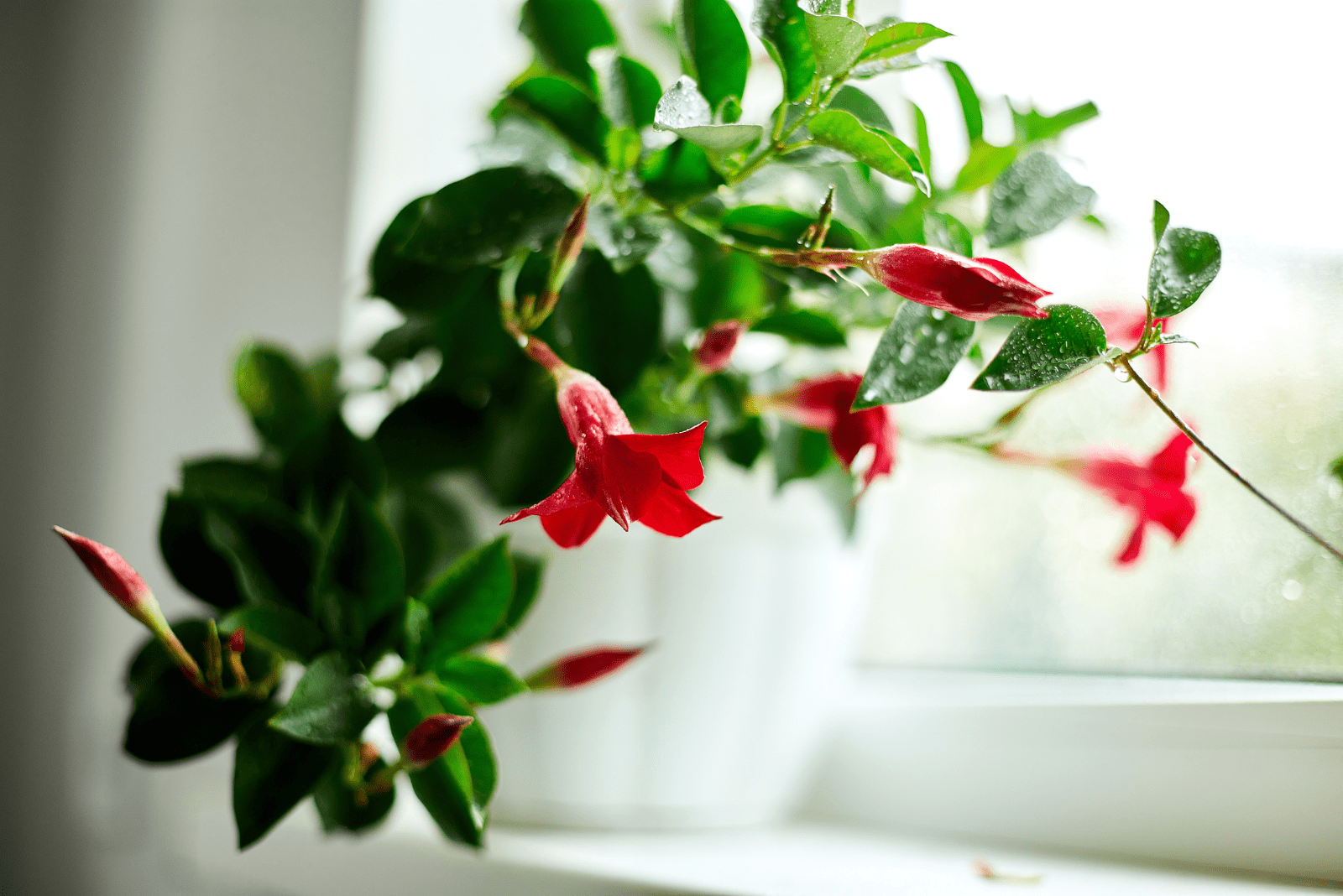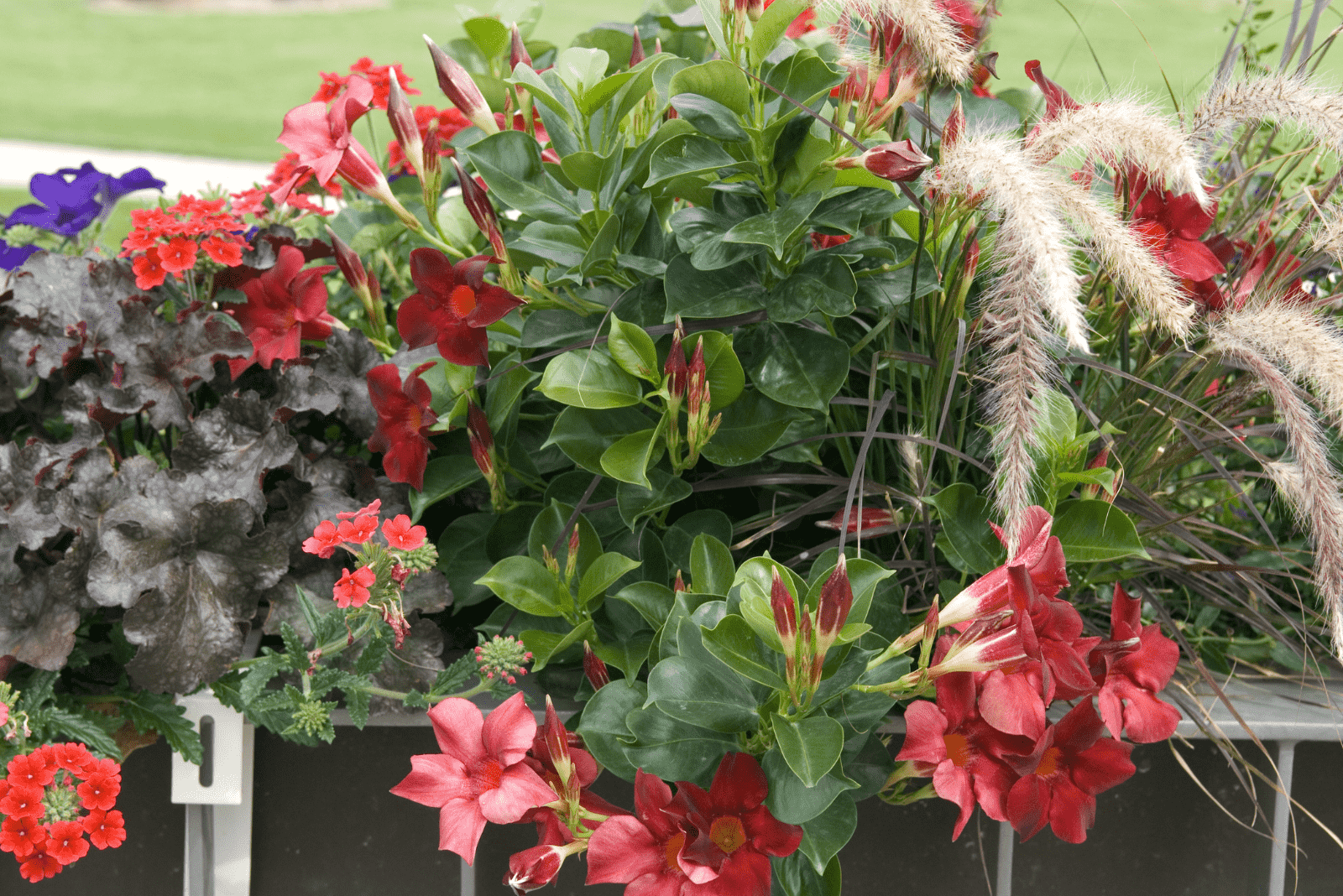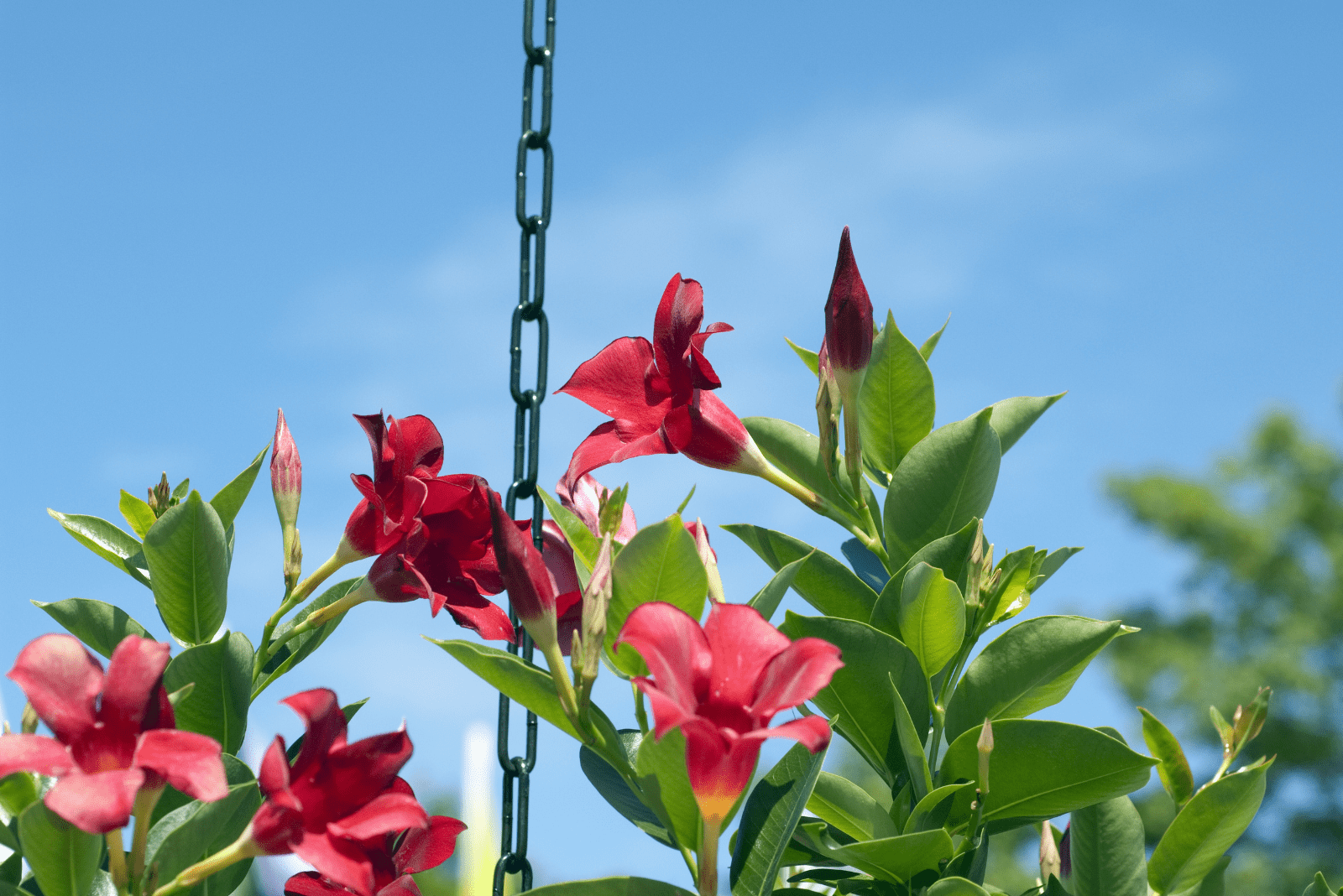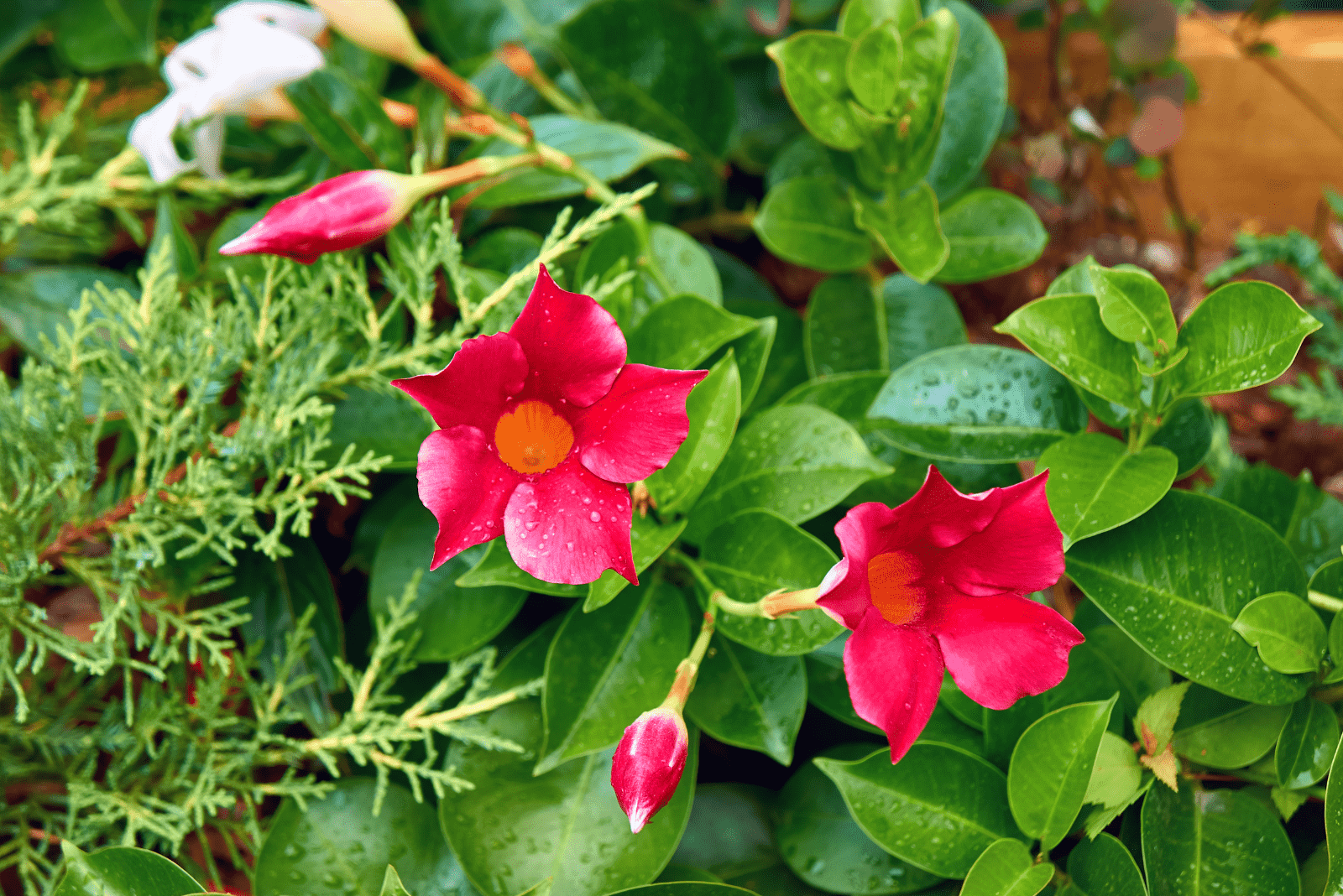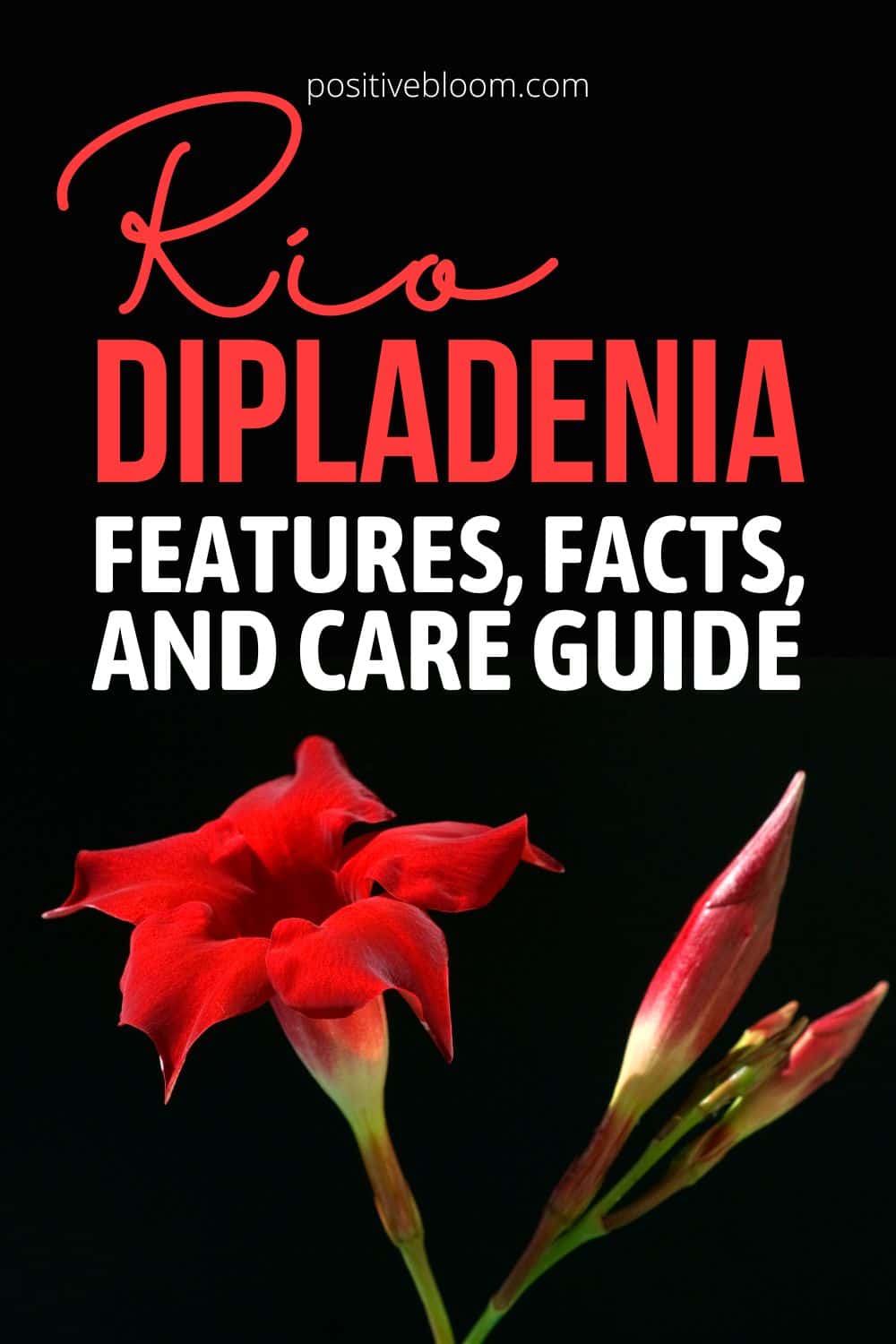The Rio Dipladenia is one of those flowering plants that look good in every setting, whether you hang it on your balcony, place it on a windowsill, or simply grow it outside.
Its bushy growth and red flowers make it irresistible to growers around the world, but there are some other aspects that we’d like to discuss in this article in addition to its main features.
Below you will find plenty of information about this plant in general, as well as a care guide to help you grow one yourself.
Before we get to all that, let’s look into the main characteristics of this plant:
[table id=308 /]Rio Dipladenia Features
The Rio plant is primarily grown for its trumpet-shaped flowers, which come in red, pink, and white.
In this plant’s natural habitat, blooms appear between March and November, although the blooming season is somewhat shorter in other climates. However, Rio flowers can still adorn your trellis panels from mid-May to mid-October.
The Dipladenia might look bushy, but it actually has a vining growth habit, which makes it perfect for growing in pots or hanging baskets.
Its leaves are deep green and glossy, pointed, and somewhat narrow, which only makes it more attractive.
Rio Dipladenia Facts
There’s been a lot of fuss about whether or not Dipladenia and Mandevilla vines are the same thing.
Well, they are, and they aren’t at the same time! Dipladenia was a separate genus, but now it is the same as Mandevilla.
However, the plants do differ, although the differences are minute. For instance, mandevilla plants have larger and broader leaves and flowers.
Another thing that distinguishes these plants is their growth habit. Although they are both vining, the dipladenia is more bush-like and doesn’t send as many upward shoots as mandevilla does, so you can grow it without staking.
Both of these plants belong to the family Apocynaceae, also known as dogbane, because many plants from this family were once used as dog poison (although neither mandevilla nor dipladenia is toxic to pets).
This tropical plant also goes by the name Brazilian jasmine, and it can fill your garden with a soft fragrance that will attract many different pollinators. The scent reminds that of jasmine, hence the name. Similarly, another plant from the Apocynaceae family, Stephanotis floribunda, got the name Madagascar jasmine due to its scent.
How To Care For A Rio Dipladenia Plant
Rio flowers are native to the tropical climates of Brazil, so you should try and grow them in warm temperatures or indoors if you live in a cold region.
Thankfully, this dipladenia is considered low-maintenance in terms of plant care and all it needs is full sun, some water, and a well-draining medium to thrive.
However, if you really want to transform your interior or exterior design, there are a couple of other things you should pay attention to, such as fertilization, repotting, propagation, and deciding whether you want to grow this plant in a pot or the ground.
We’ll discuss all these things in detail in the sections below, and you’ll be able to enjoy a wonderful trail of pink, red, and white flowers in no time!
Rio Dipladenia In Pot Vs Ground
The first thing you need to decide is whether you want to add them to your container garden collection or plant them in the ground.
The Rio dipladenia plant is ideal for pots and hanging baskets because it doesn’t grow too fast, and you won’t have to repot them that often.
However, as they are vining plants, it’s best to grow them in a container for a while and then train them onto a trellis to make them the focal point of your design. You can also let them hang from a hanging planter and improve the decor that way.
There is nothing that can stop you from planting this tropical vine in the ground, except for the weather.
These plants prefer mild temperatures, and if your region experiences cold winters, they won’t make it through.
Therefore, growing these plants in containers can make it possible to overwinter them inside and then take them out when spring arrives.
Light Requirements
Dipladenia requires full sun, whether you grow it as a houseplant or an outdoor plant. Therefore, you must make sure to place it where it can get between 6-8 hours of direct sunlight per day (the bare minimum is 4 hours of natural light each day).
However, if you live in hot climates, your plant might not need that much sunlight. In fact, harsh light could burn the leaves and flowers, so you should move it to a more sheltered area.
For instance, a place that gets direct sunlight in the morning and in the late afternoon is ideal as this light is not that dangerous.
If you have decided to grow your plant indoors, you can always keep it near a sunny window.
Water And Humidity
Even though these plants come from the tropics, they actually require little watering because they store water in their tubers.
You should let the soil dry to a certain degree (the top 2-3 inches, for instance) in between waterings to avoid fungal diseases such as root rot.
This is an easy care plant and can live from rainfall in more humid regions. Still, it doesn’t mean they can survive without irrigation in drier climates, so water them once the topsoil dries.
Another thing I’d like to pay attention to is the type of water you use for watering your plants. Sometimes, water that’s good for people isn’t suitable for your plants.
For instance, tap water might not harm us (if it is safe to drink according to EPA standards), but your plants might suffer from chlorine buildup.
When it comes to the best water for plants, the answer is simple. Distilled water is the safest option for your plants, and it won’t make them sick due to chloride poisoning (or some other mineral).
However, you can use tap water if you leave it in the air for about 24 hours so that the chlorine can evaporate.
Humidity
Finally, some good news about this tropical plant! It doesn’t require extra humidity!
Even though its native region is relatively moist compared to other climates, you don’t have to think of ways to raise outdoor humidity.
This plant mostly absorbs water through its roots, and you don’t have to mist it, invest in humidifiers, or anything else of the sort.
If the weather is scorching and you keep this plant outside, you’ll need to water it more often because the water in the soil will evaporate faster. Your plant will also have to use more due to the increased transpiration rate.
Temperature
The Rio dipladenia cannot be grown outside in all USDA zones because it cannot survive the winter cold. It thrives in zones 9-11, but you can grow it in zone 8 as well.
However, there’s a big possibility the plant will die back in winter and then resume its growth in spring. However, the plant would become smaller in this case, so you should take it indoors where temperatures aren’t lower than 45°F.
This plant even needs warm nighttime temperatures, so you shouldn’t allow them to fall below 65°F.
Another thing you should be mindful of is placement. Don’t keep this plant near drafty windows, air vents, or heaters, as the temperature in those places isn’t constant, and your plant might get stressed out.
Soil And Fertilizer
The Rio plant is an excellent addition to your outdoor petunias and requires pretty much the same growing medium.
This flower requires fertile and well-draining soil, so you should amend the substrate if it is too heavy. For instance, growing this plant in loam-based compost such as John Innes No 3 with some sand for gardening is an excellent way of providing enough drainage.
Making a DIY planting mix isn’t that complicated, simply add some perlite, peat moss, and sand to quality potting soil, and your plant will be just fine.
However, you shouldn’t strive for extreme drainage as that will just increase your watering chores. If your garden soil is more sandy, you can amend it by adding some compost or humus to increase water retention.
These ingredients can increase drainage in heavy soils, but in sandy ones, they will make it more moisture-retentive without clogging your plant with water.
Finally, don’t forget to mulch this plant. A thin layer of bark or straw can keep your Rio dipladenia warm in winter and cool in summer.
Mulch can also prevent excessive evaporation, which is perfect for on-the-go gardeners who don’t have much time for watering their plants.
Fertilizer
Dipladenias are not heavy feeders, so you can get away with fertilizing them once a month during their growing season with a good liquid fertilizer.
However, you can make your life a lot easier by applying a slow-release fertilizer in early spring to give your plant a year-round supply of nutrients.
You don’t need to (or rather shouldn’t) feed these plants in winter as that’s when they’re dormant and don’t need the additional nutrients.
Balanced fertilizers are just fine, but you can also use one with a bit more phosphorus, such as 7-9-5 or 6-10-4, to entice flowering.
Another thing you should pay attention to when feeding your plants is watering. Always irrigate your plants before fertilization to reduce the risk of burnt roots.
Repotting
Even though the Rio dipladenia plant is a slow grower, you should still repot it once a year to replenish the nutrients and prevent salt build-up caused by fertilization.
The best time to repot this plant is in early spring after it wakes from dormancy. This technique will reduce the risk of transplant shock and give your dipladenia time to recover before winter arrives.
All you need is a couple of houseplant tools like gloves, soil mix, a new pot (one size larger if your plant is still gaining height), etc.
The first thing you need to do is make sure that your plant is well-hydrated before moving it to its new home in order to reduce transplant shock. Repotted plants can become stressed and have difficulty absorbing water for a few days after repotting, and proper hydration can help with this issue.
Once you prepare your plant for the transplant, remove the soil around it, tip the container to one side, and gently take the plant out (and trellis if there is one).
Fill the new pot with some fresh medium, place the plant in it, and then fill the container with the rest of the soil.
Water the plant thoroughly after repotting it and put it back in its usual place.
Propagation
One of the things I adore most about this tropical vine is that its stems can root quickly, so you can use the cuttings to safely propagate this plant and create an actual pollinating garden where bees, bumble bees, and hummingbirds would be frequent guests.
There are a couple of things you should know about multiplying these plants, but we’ll cover the basic steps in the guide below:
Step 1. Choose a healthy stem with plenty of leaves and take a cutting approximately 6 inches long. Make the incision at a 45° angle to ensure better absorption.
Step 2. Dip the cuttings in a rooting hormone to speed up the entire process.
Step 3. Fill nursery pots with a seed starting mix, or make your own by mixing equal amounts of horticultural sand, perlite, and peat moss.
Step 4. Water the cuttings and move them to a brightly lit area. Cover the pots with a humidity dome or a plastic wrap to increase humidity and the chances of success.
Step 5. You can also place the nursery pot on a heating mat to regulate the temperature. Ensure that the temperatures are around 60°F during the night and 75°F in the daytime.
Step 6. Water the cuttings whenever the soil seems dry. Lift the humidity dome or plastic sheet from time to time to introduce fresh air to your new plant.
Step 7. Once you notice that your plant has put on some new growth, wait a bit longer and then transplant it into a larger pot.
Pruning
Pruning the Rio plant is an essential part of its care routine. Pruning will introduce more airflow and allow the light to get to the inner parts of the plant, keeping it healthy and in shape.
If you find this chore tedious or experience pain in your hands, you can always get some secateurs for arthritic hands from your local retailer or order them online. These pruners have ergonomic handles and require much less pressure from your hands to work.
You shouldn’t cut the main stem, but the top and side shoots should be trimmed down to 2-3 leaves. There are still buds on those stems, which will produce new leaves and flowers.
You can prune this plant however you like. I like to follow the shape of the trellis it is growing on.
There are many things that I love about this plant, but one makes my life a lot easier. The Rio dipladenia doesn’t need deadheading, so you can leave the dried and dead flowers alone, and they’ll fall off on their own.
Here are some more useful tips for pruning a dipladenia:
Pests And Diseases
Unfortunately, this plant is not resistant to aphids and spider mites, but there are a couple of things you can do to prevent pest infestations and deal with them (almost) effortlessly.
These bugs usually attack unhealthy plants that aren’t getting adequate amounts of water or sunlight. Therefore, if you ensure you take good care of your plant, who knows, it might never get infested!
But it is highly likely that you’ll have to deal with these nuisances sooner or later, so you should learn how to deal with them.
One of the best natural ways to deal with these pests is by introducing some ladybugs, as they are the mortal enemies of aphids and mites. You can also remove smaller infestations with the help of a Q-tip and rubbing alcohol or neem oil.
However, removing larger groups of bugs with a single Q-tip would take forever, so using some pesticides in this situation is a good idea.
Diseases
Anthracnose is a common disease that affects this plant. It is manifested as brownish leaf spots and lesions, and dieback. Foliage may even start to fall off in extreme cases.
But there is a way to prevent this unsightly problem. Anthracnose is caused by constantly wet leaves, so you should avoid overhead watering, splashing, and wetting the plant’s foliage.
But if you do notice the symptoms, you should isolate the diseased plant from the healthy ones, remove the infected leaves, and treat the rest of the dipladenia with a fungicide.
You Asked Us
Even though we have covered many things about the Rio dipladenia, we still need to discuss a few more things before we call it a day.
We chose a couple of your questions to answer in the sections below.
Is the Rio dipladenia a perennial?
The Rio dipladenia can be both a perennial and an annual plant, depending solely on the weather conditions in which it is grown.
In its native habitat and similarly warm climates, this plant is an evergreen perennial.
However, the Rio plant cannot survive cold temperatures, which is why it can be grown as an annual in such conditions, or you can overwinter it indoors and take it outside once the weather warms up.
How long do Rio dipladenia flowers last?
The Rio dipladenia plant stays in bloom for about two weeks, but don’t get sad just yet.
These plants flower almost all year long (in normal conditions from May to October, but in perfect conditions from March to November), so you can enjoy new sets of flowers every other week.
Final Word
This article examined everything you need to know about the Rio dipladenia. We included its main features and some facts about this plant, as well as a detailed care guide.
Now you know how to take care of the Rio Dipladenia, where to plant it, and how to propagate it, so you can transform your garden into a true paradise.
We also presented some common pests and diseases that afflict this plant, so you know what to do if it ever comes to that.
Enjoy this colorful plant, and until next time!
Like this post? Share or pin it for later!

